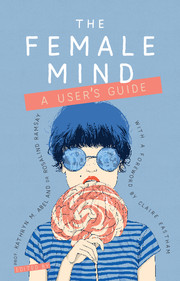Book contents
- Frontmatter
- Acknowledgements
- Contents
- Foreword
- Introduction: being female
- Part I Women in perspective
- Part II Women and society
- Part III Women and their environment
- Part IV Women and specific disorders
- 18 Depression and other mood disorders
- 19 Anxiety disorders
- 20 Trauma and post-traumatic stress disorder
- 21 The dangers of rumination
- 22 Obsessive–compulsive disorder
- 23 Eating disorders and body dysmorphic disorder
- 24 Psychosexual disorders
- 25 Personality disorders: risks and recovery
- 26 Self-harm
- 27 Women and addiction
- 28 Autism spectrum disorder
- 29 Attention-deficit hyperactivity disorder
- 30 Psychotic illness
- 31 Postnatal depression and postpartum psychosis
- 32 Living longer: normal age-related changes, dementia and depression
- Part V Women and treatment
- Contributors
- Index
19 - Anxiety disorders
from Part IV - Women and specific disorders
Published online by Cambridge University Press: 02 January 2018
- Frontmatter
- Acknowledgements
- Contents
- Foreword
- Introduction: being female
- Part I Women in perspective
- Part II Women and society
- Part III Women and their environment
- Part IV Women and specific disorders
- 18 Depression and other mood disorders
- 19 Anxiety disorders
- 20 Trauma and post-traumatic stress disorder
- 21 The dangers of rumination
- 22 Obsessive–compulsive disorder
- 23 Eating disorders and body dysmorphic disorder
- 24 Psychosexual disorders
- 25 Personality disorders: risks and recovery
- 26 Self-harm
- 27 Women and addiction
- 28 Autism spectrum disorder
- 29 Attention-deficit hyperactivity disorder
- 30 Psychotic illness
- 31 Postnatal depression and postpartum psychosis
- 32 Living longer: normal age-related changes, dementia and depression
- Part V Women and treatment
- Contributors
- Index
Summary
Linda's story
Linda is a 30-year-old nurse who works part-time and has two young children. Although always an anxious person, she began noticing that she was becoming more anxious about 3 years ago. At this time her eldest child started school and she had to take her baby to nursery, drop the oldest boy at school, and then go to work at a local health centre where she worked from 10 am to 2.30 pm. She found this rushing to several places stressful and noticed she was finding it hard to concentrate because of her increasing anxiety: she was constantly worrying that she would not make it to either work or school on time.
Her husband noticed she was stressed and suggested she talk to her general practitioner (GP). Linda was reluctant at first as she felt she should be able to ‘snap out of it’, but eventually agreed. The GP thought that she seemed very stressed and discussed treatment options with her. Linda did not want to take medication but agreed to a referral to the local psychological well-being service for a course of cognitive– behavioural therapy (CBT). Linda's GP also encouraged her to eat regular meals, avoid excessive caffeine drinks and alcohol and stop smoking, to help reduce her symptoms. The GP told her that regular exercise also helps some women overcome some of the symptoms of anxiety.
Linda started taking good care of her general health by eating well-balanced meals, reducing her alcohol consumption to no more than a small glass of wine on a maximum of 5 days a week, reducing her coffee drinking and joining a fitness club. She went on a quit-smoking course and hasn't smoked for 6 months. Linda also attended five CBT sessions, in which the therapist helped her identify some of her ‘trigger’ thoughts – the ones that caused feelings of anxiety – and helped her deal with these thoughts, as well as exploring her ways of coping.
Linda now feels well and able to enjoy life. She admits that she does become stressed and anxious at times but, instead of entering into a vicious circle of anxiety, worry and guilt, she knows she can examine the reasons she feels stressed and try to work out the best possible solutions.
- Type
- Chapter
- Information
- The Female MindUser's Guide, pp. 123 - 127Publisher: Royal College of PsychiatristsPrint publication year: 2017

